21 Types of Duck in Georgia (With Pictures)
Last Updated on
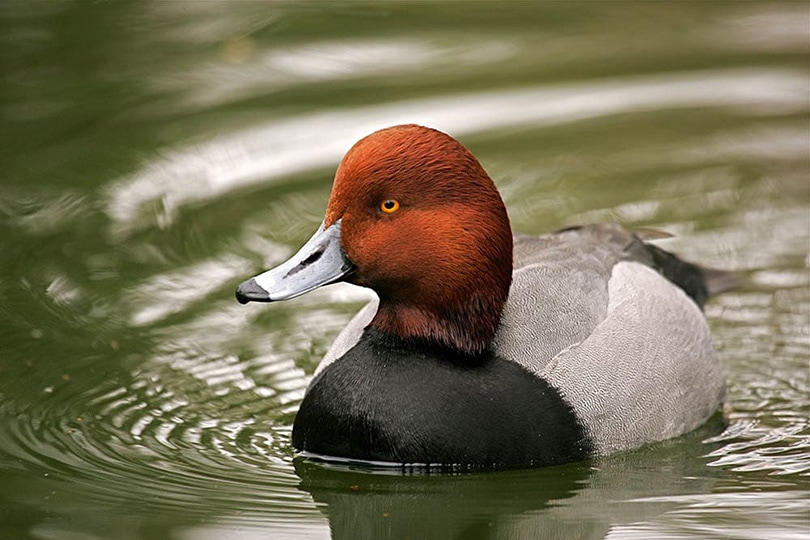
When you’re living in Georgia, you have the chance to see an incredible variety of waterfowl throughout the year. While some ducks and other birds may be easy to identify, others may have mated with pet birds and produced hybrid offspring. We’ve created a list of the most common ducks to visit Georgia, but you’re likely to see other rare ducks that only visit the state for brief periods.

Diving versus Dabbling Ducks
Ducks are classified into two groups: diving ducks and dabbling ducks. Diving ducks swim underwater to consume plant material and invertebrates. Their wings are shorter than dabbling ducks so they can swim easier underwater. Dabbling ducks float on the water’s surface and submerge their heads to grab plants and tiny marine creatures.
The 21 Types of Ducks in Georgia
Diving Ducks of Georgia
1. Greater Scaup

You’re less likely to see a Greater Scaup in Georgia in the summertime. The birds breed in arctic regions in summer, and some of them fly over to Europe at the end of the season. The Greater Scaups have long gray bills with black tips. Males have black and white bodies with speckled feathers and a green head. Females have brown bodies, brown heads, and a white patch at the base of the skull. The birds prefer congregating in groups around large bodies of water, and they’re expert divers that can plunge 20 feet underwater for quick meals.
2. Lesser Scaup

Lesser Scaups look like Greater Scaups, but their heads are more pointed than the round head of the Greater species. Lesser Scaups are more prolific in North America than other diving birds, but you’re unlikely to see one on a lake or pond. They gather in the thousands and congregate in large estuaries and reservoirs. Unlike the Greater Scaups, Lesser males have shiny, black-colored heads. Their bodies are black and white and speckled like their Greater cousins, but the Lesser females are harder to distinguish from Greater females. They have similar plumage and the same white ring on the base of the head, but Lesser ducks have a darker color like the hue of dark chocolate.
3. Red-breasted Merganser

In the warmer months, Red-breasted Mergansers breed in the boreal forest in North America and spend most of their time around large lakes. They travel south in the winter to coastal areas, and you’ll have a better chance of spotting one in Georgia at that time. Mergansers are skinny birds with long necks and bills, and males have more prominent plumage than females. Males have red eyes, rust-colored chests, and green heads with a pointed crest. Females are brownish-gray on their heads and bodies. Most of the Merganser’s diet is fish, and few hunters target the species because of its marine diet. Fish-heavy diets make duck meat less appealing to diners than other species with plant-based diets.
4. Hooded Merganser
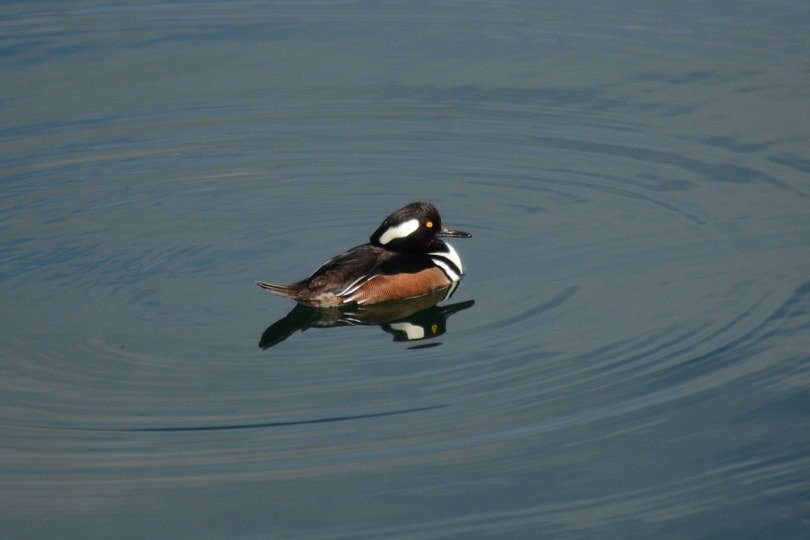
Hooded Mergansers are small ducks, and they have a unique appearance much different than the Red-Breasted variety. Males have large round heads that are black with a large white crest, and females are primarily brown overall with a mohawk-like tuft of hair on their heads. The birds have serrated bills to help them catch insects, crawfish, and fish. Female Mergansers sometimes sneak over to another nest to lay their eggs, and the unfortunate owner of the crowded nest must raise twice the number of ducklings.
5. Common Goldeneye

These ducks can stay submerged for over a minute while hunting for marine life, and they enjoy feasting on plant tubers, invertebrates, and small fish. They’re quiet birds except when they’re mating, but their wings make a whistling sound when they fly that’s recognizable by experienced hunters. Female Goldeneyes have yellow-tipped short, dark bills with brown heads and gray and white bodies. Drakes have dark green heads with a white patch on the cheeks and white bodies with a black rump. Goldeneyes have stable population numbers, but they often lose their nests to deforestation. Instead of constructing nests, Goldeneyes prefer to occupy hollowed-out trees.
6. Ring-necked Duck

Although its name suggests a prominent ring around its neck, the Ring-necked Duck is not easy to identify by its ring. The circular patch of lighter hair is not discernible from a distance, and it’s more prominent in males than females. Males are mostly black with grey sides, and females have brown plumage with grey necks and faces. Both sexes have a white ring at the tip of their gray bills. Ring-necked Ducks prefer the shallow waters of wetlands around Georgia, and during the winter, they gather in massive groups around large un-frozen lakes.
7. Redhead

Redhead ducks are sociable birds that like to gather in large groups, and their curiosity sometimes gets them into trouble. Redheads are more drawn to wooden decoys than other ducks, and hunters consider them easier to hunt than other species. Males have stunning cinnamon-colored heads, black chests, and gray bodies. Females have brown bodies with lighter shades on their heads and faces. Like the Hooded Mergansers, Female Redheads sometimes deposit eggs in other nests. However, they often leave their eggs in the nests of other species like Mallards, Gadwalls, and Ruddy Ducks.
8. Ruddy Duck

Ruddy Ducks are more skilled in the water than the air, and they will quickly dive into the water to evade predators rather than taking flight. The male Ruddy is a stunning bird with red and black plumage and a light-blue bill. Females have brown feathers and a dark bill. If you’re lucky, you may spot a male Ruddy performing an unusual ritual during mating season. The duck furiously beats its wings while floating to create a small pool of bubbling water, and he ends the show with a loud belch.
9. Canvasback
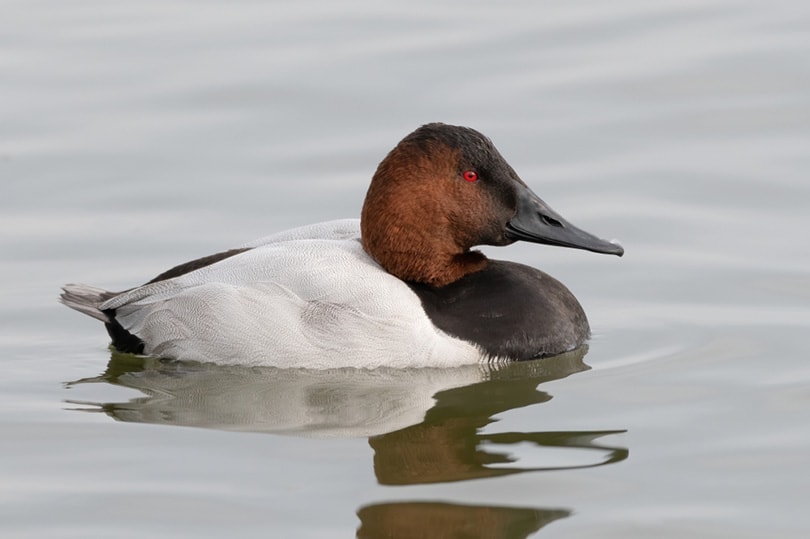
If you’re searching for Canvasbacks in Georgia, you’re unlikely to see one near land. The birds love the water, and they even stay on the surface near the water’s bank to sleep. When they build nests, they place them on floating vegetation in the water. The males have black chests, gray bodies, and reddish-brown heads with red eyes. Females have brown heads, black eyes, and gray bodies. Canvasback populations are stable, but they’ve declined slightly from the loss of wetlands and the disappearance of their favorite wild celery plants.
10. Bufflehead
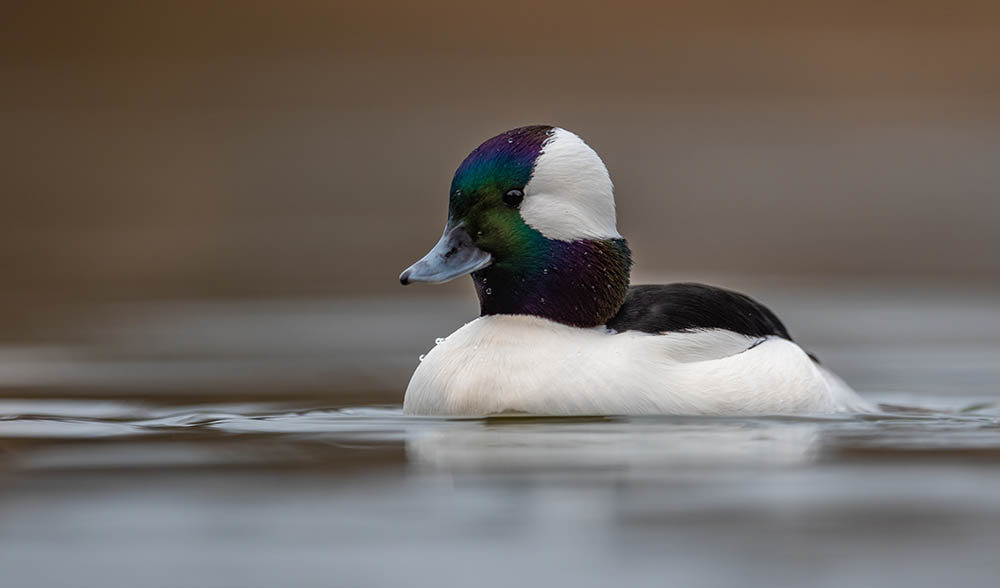
Buffleheads are quieter than other species, but you can hear the males whistle during mating season. They’re small ducks that often take over the abandoned nests of Pileated Woodpeckers or Northern Flickers. Buffleheads spend long periods underwater hunting crustaceans and invertebrates, and they even consume their meals before surfacing. Males have shiny purple/green feathers on their faces and white bodies with black rumps. Females have brown bodies, darker heads, and a bright white patch on their cheeks. Logging has decreased the number of nesting sites available to the birds, but Buffleheads have adapted well by inhabiting human-made nesting boxes.
Dabbling Ducks of Georgia
11. Black-bellied Whistling-Duck

The Black-bellied Whistling-Duck is one of the few species where both males and females look the same. They have long legs, cinnamon-colored bodies with white patches on the wings, and red bills. They mainly eat plants and leftover grains from harvested fields, and they’re more comfortable perching in trees than congregating around water. The whistling ducks were named after their unique vocalizations that begin with long, high-pitched whistles and end with shorter tones.
12. Mottled Duck

Both males and females have brown, mottled bodies, but the males have yellow bills with black tips, and the females have black bills with yellow tips. Mottled ducks are easy to confuse with female Mallards, and both species tend to gather together and make identification even more difficult. Because of this, they often inhabit the same area as Mallards, and Mottled Ducks sometimes mate with Mallards. Although their populations are not currently threatened, some avian experts worry that the Mottled species may eventually disappear due to hybridization with other species.
13. American Black Duck
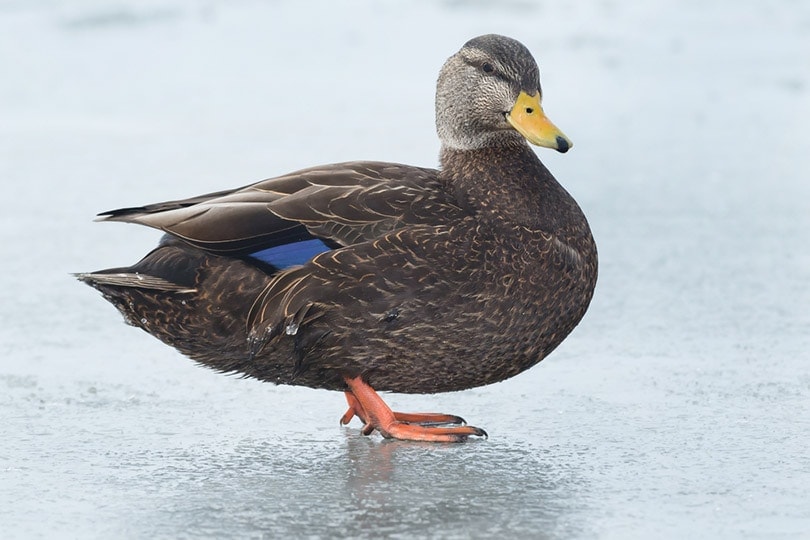
Although its name suggests otherwise, the American Black Duck is not black. Both sexes have dark brown feathers with lighter-colored heads, but the males have yellow bills, and females have olive bills. The birds have a patch of iridescent purple on their wings that you can see easier when they’re flying. Like the Mottled species, Black ducks are sometimes hard to distinguish from Mallards. They often mate with Mallards, and recent studies suggest that American Black Duck populations have declined due to the expansion of Mallard populations.
14. Wood Duck
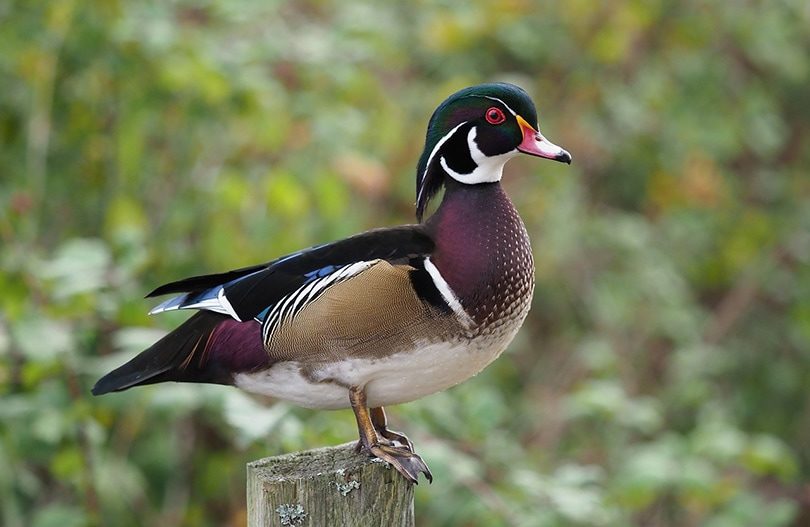
Wood ducks build their nests in hollowed-out sections of tall trees, and their young sometimes drop several feet when they make their first trip away from the nests. Both sexes display vibrant colors, but the male birds have multicolored heads and wings, including red, green, orange, lime, brown, and many other colors. Males have red eyes with green crested heads, and females have gray heads and dark eyes surrounded by white rings. Wood Ducks have strong, sharp claws to help them climb and grasp tree branches, and they usually stay quiet unless they’re disturbed by a predator or wandering human.
15. Green-winged Teal

At less than 15 inches long, the Green-winged Teal is the smallest dabbling duck to visit Georgia. Females can weigh as little as 5 ounces, and males typically weigh up to 18 ounces. When the ducks are mingling with other species, they’re easier to distinguish because of their smaller size. Males have rust-colored heads with green stripes running from their eyes to their necks and gray/tan bodies. Females have mottled brown heads with gray and brown bodies. Both sexes have bright green patches on their wings that you can see when sitting or flying.
16. Blue-winged Teal

Mallards are the most common dabbling duck in North America, but Blue-winged Teals are a close second. Males have black wings and bills with brown polka-dot bodies. They have blue heads with a bright white stripe behind their eyes. Females have gray/brown heads and brown bodies. The birds are popular with hunters because the prominent blue patches on their wings are easy to target when flying. You can find Blue-winged Teals gathered around the shallow wetlands of Georgia.
17. Northern Shoveler
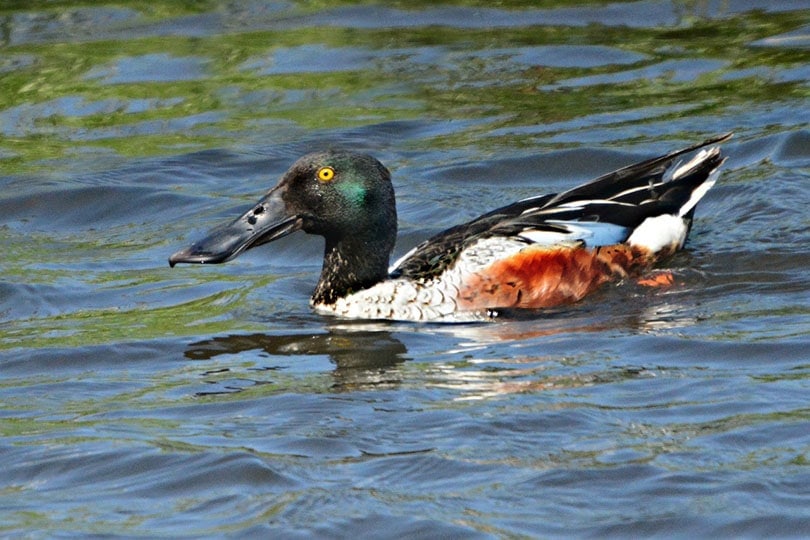
Northern Shovelers have massive, scoop-like bills that help them dig into muddy banks for mollusks, insects, and other tiny marine creatures. Female Shovelers have brown plumage on their heads and bodies with a slight blue hue on their wings. Males have red and brown bodies with white chests and green heads. Northern Shovelers have specialized bills with tiny projections called lamellae that help them filter out debris while searching for food.
18. Northern Pintail

Although they prefer the shallow wetlands in Georgia located away from humans, Northern Pintails also forage on pasture lands for bits of corn and grains. They’re slender birds with long necks and pointed tails. Males have red-brown heads, white throats, and gray bodies. Their pointed tales are much longer than the females’, and they stick out higher than their heads when the birds float in water. Females have tan heads, black bills, and brown bodies. Females make an ordinary quack sound, but the males have high-pitched screams similar to whistles used by gym teachers.
19. Mallard
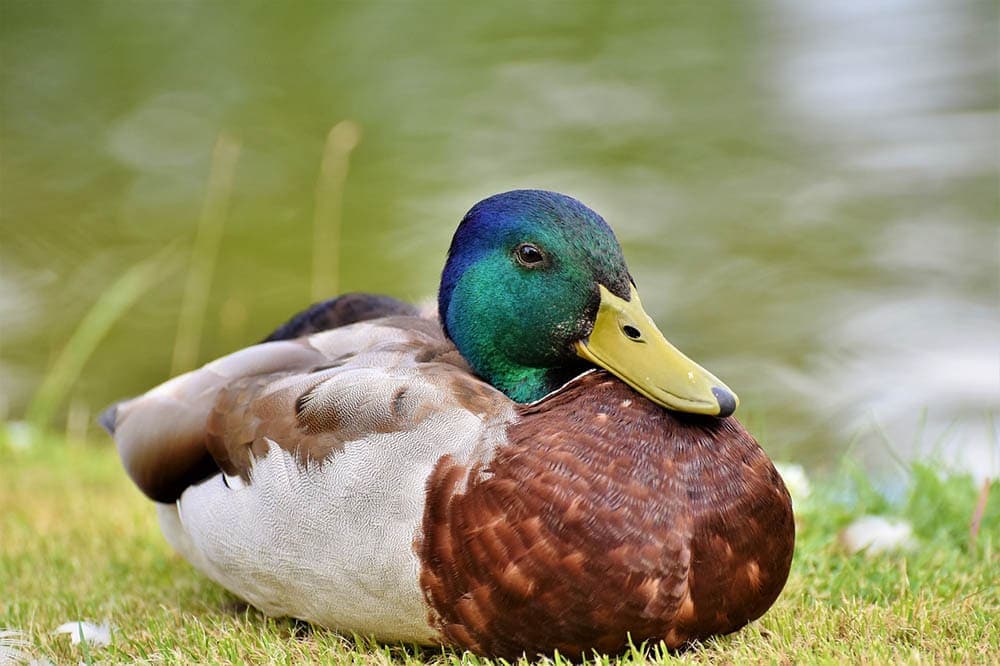
Unlike many duck species, Mallards are not afraid of people, and they’re just as comfortable floating in a swimming pool as a small pond. Except for the Muscovy ducks, Mallards are related to all the species of ducks around the world. Females have mottled brown plumage with brown and orange bills. Males have white rings around their reddish-brown chests and bright green heads with yellow bills. Both sexes have shiny blue sections on their wings that are easier to spot when they’re flying. Because they’re so common in Georgia and around North America, you’re more likely to see Mallards than other species.
20. Gadwall
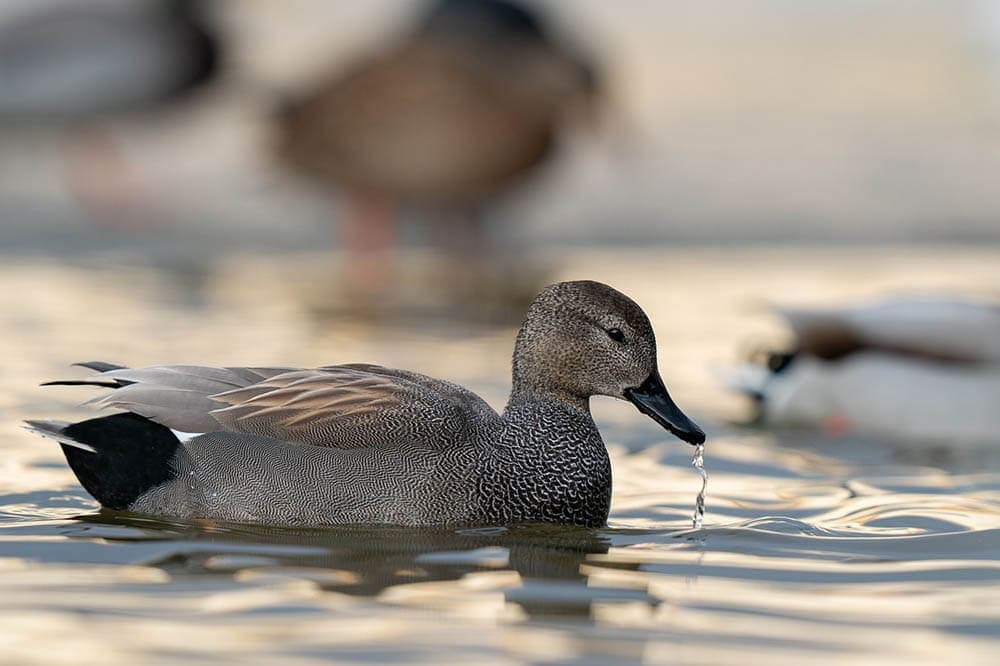
Gadwalls stay in the western states during mating season, but they move east after breeding to inhabit wetlands with dense vegetation. Most of the duck’s diet is plant-based, but the Gadwall also enjoys stealing the marine prey of diving ducks in the summertime. Females have mottled brown bodies with orange and black bills. Males have brown heads, black bills, and complex patterns of brown, gray, black feathers on their chests and wings. Male Gadwalls have strong calls that sound like human belches.
21. American Wigeon
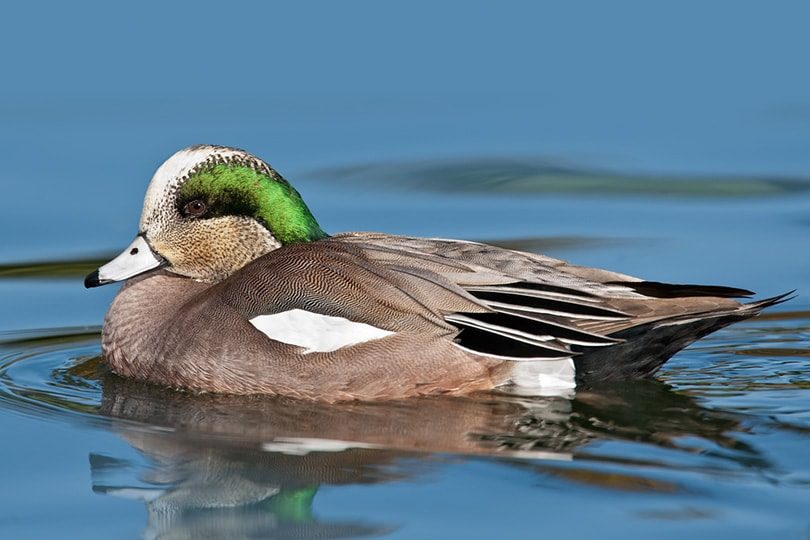
You’re more likely to see American Wigeons in Georgia during the winter, but they’re not easy birds to study. They prefer to congregate in isolated lakes away from people, and they tend to fly away when humans approach. Females have brown bodies, gray heads, and distinctive light-blue bills. Males have brown and white heads with green stripes behind their eyes. They have white bills with black tips, and unlike the female’s deep quack, they make three short whistling sounds.

Birdwatching for Ducks
All the breeds we discussed are entertaining to observe and study, but you may not see some birds for very long if you disturb their territory. When you visit a new area for birdwatching, walk around and look for nests in the trees or by the water’s edge. Most ducks are not aggressive, but they’re protective of their nests, and they tend to be rowdier and more vocal around mating season. If you try to stay hidden behind dense vegetation like a duck hunter, you’ll have a better chance of watching the birds and taking photos.
Watching the gorgeous waterfowl is a rewarding activity but be sure not to offer any treats to our feathered friends. Ducks are skilled foragers that have survived for centuries without consuming salty human snacks.

Conclusion
With its warm climate and abundance of wetland areas, Georgia is an excellent state for viewing several species of dabbling and diving ducks. We covered 21 species, but you may see other ducks visit the state from time to time. The habitats of several species of waterfowls and other birds are threatened by human development, so the birds must shift their migratory patterns and find new nesting spots to survive. Thankfully, the species we covered have stable populations and continue to astound us with their beauty and unique behavior.
Featured Image Credit: Tom Reichner, Shutterstock
Table of Contents
- Diving versus Dabbling Ducks
- The 21 Types of Ducks in Georgia
- 1. Greater Scaup
- 2. Lesser Scaup
- 3. Red-breasted Merganser
- 4. Hooded Merganser
- 5. Common Goldeneye
- 6. Ring-necked Duck
- 7. Redhead
- 8. Ruddy Duck
- 9. Canvasback
- 10. Bufflehead
- 11. Black-bellied Whistling-Duck
- 12. Mottled Duck
- 13. American Black Duck
- 14. Wood Duck
- 15. Green-winged Teal
- 16. Blue-winged Teal
- 17. Northern Shoveler
- 18. Northern Pintail
- 19. Mallard
- 20. Gadwall
- 21. American Wigeon
- Birdwatching for Ducks
- Conclusion
About the Author Robert Sparks
Robert’s obsession with all things optical started early in life, when his optician father would bring home prototypes for Robert to play with. Nowadays, Robert is dedicated to helping others find the right optics for their needs. His hobbies include astronomy, astrophysics, and model building. Originally from Newark, NJ, he resides in Santa Fe, New Mexico, where the nighttime skies are filled with glittering stars.
Related Articles:
Monocular vs Telescope: Differences Explained (With Pictures)
10 Types of Hummingbirds in Arkansas (With Pictures)
8 Types of Hummingbirds in Nebraska (With Pictures)
5 Types of Hummingbirds in Idaho (With Pictures)
3 Types of Hummingbirds in Mississippi (With Pictures)
8 Types of Hummingbirds in Kansas (With Pictures)
5 Types of Hummingbirds in West Virginia (With Pictures)
5 Types of Hummingbirds in Ohio (With Pictures)
